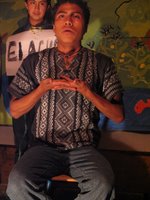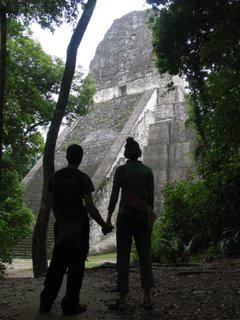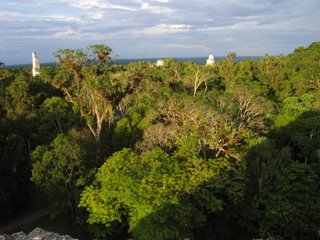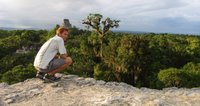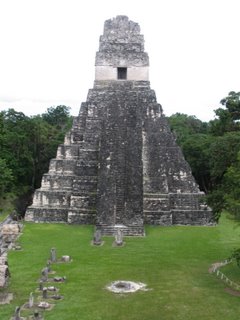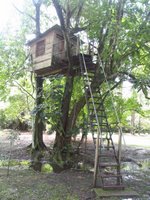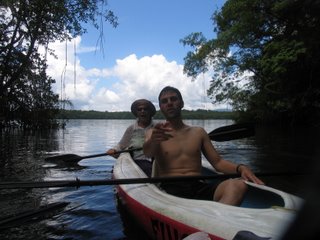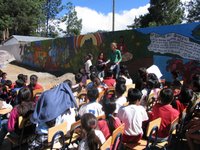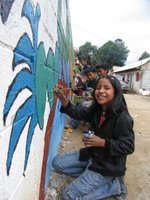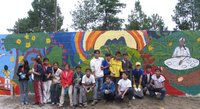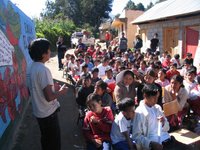Theater Festival: The Mysterious Tree


October 13th was our theater festival, and it was a huge hit. With a live seven-piece marimba band and two one-hour plays, we were the event of the week. An audience of 150 was polite and quiet as we abandoned the microphones and had them sit through pitch-black transitions. We went all out with sound effects and lighting—having earlier recorded fireworks and later performing part of the night with shadow-theater—to make it a unique experience for all. While the house filled, the marimba band Voces de Selva played for an hour. The first play, El Árbol Misterioso (The Mysterious Tree) was performed by Tercero Básico (equivalent to sophomore year in high school). And the second, Ayer y Mañana (Yesterday and Tomorrow), was performed by Quinto Bachillerato (seniors in high school). We ended the night with a nervous energy converted into screams of joy, more marimba, coffee, and corn on the cob slathered in ketchup, mayonnaise, and hot sauce. Coming home at one in the morning, I was brimming with pride in the students and their accomplishment. I was worried the whole event would fall apart since we pulled the plays together only the week before, but on performance night the students rose to the occasion and I was pleasantly surprised.
El Árbol Misterioso
A rural community is faced with corrupt leaders who allow a mining company to cut down its enchanted forest. But a special, magical, mysterious tree can’t be cut down, and as they pound its trunk with their machetes its shadow grows larger and larger, before it begins to drop seeds. Accompanied by the sounds of a live flute in the background, the forest grows back stronger than ever. The shadows of the cardboard props bounce up and down and the audience giggles in delight.
 The humans try to destroy the forest again, this time with dynamite, and again one-by-one the arbolitos fall. Mother Nature exploded into bits and pieces. But in the morning the humans find that not only have the trees grown back, but the mysterious tree has overtaken their house when they wake alongside the birds, high above the land.
The humans try to destroy the forest again, this time with dynamite, and again one-by-one the arbolitos fall. Mother Nature exploded into bits and pieces. But in the morning the humans find that not only have the trees grown back, but the mysterious tree has overtaken their house when they wake alongside the birds, high above the land. 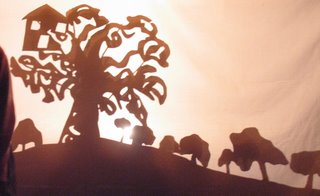 The mining company abandons the project and the people are drawn towards the mysterious tree, trying to understand Mother Nature and its capabilities. They think that if they eat the fruit they too will have magical powers, and one by one they declare their dreams of building a house, creating a tree nursery, becoming a singer, and building a better community. But it turns out that the tree’s fruit didn’t have any magical powers: the play ends with the insightful voice of the tree explaining that the humans—just like the tree, the worms, potatoes, and everything else made by the creator—all have the same inexplicable energy and power infused in their souls. They just didn't realize it.
The mining company abandons the project and the people are drawn towards the mysterious tree, trying to understand Mother Nature and its capabilities. They think that if they eat the fruit they too will have magical powers, and one by one they declare their dreams of building a house, creating a tree nursery, becoming a singer, and building a better community. But it turns out that the tree’s fruit didn’t have any magical powers: the play ends with the insightful voice of the tree explaining that the humans—just like the tree, the worms, potatoes, and everything else made by the creator—all have the same inexplicable energy and power infused in their souls. They just didn't realize it.

